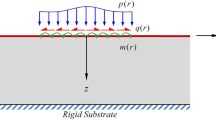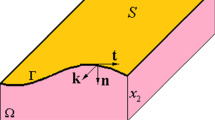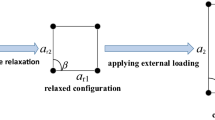Abstract
Within the context of Gurtin–Murdoch surface elasticity theory, closed-form analytical solutions are derived for an isotropic elastic half-plane subjected to a concentrated/uniform surface load. Both the effects of residual surface stress and surface elasticity are included. Airy stress function method and Fourier integral transform technique are used. The solutions are provided in a compact manner that can easily reduce to special situations that take into account either one surface effect or none at all. Numerical results indicate that surface effects generally lower the stress levels and smooth the deformation profiles in the half-plane. Surface elasticity plays a dominant role in the in-plane elastic fields for a tangentially loaded half-plane, while the effect of residual surface stress is fundamentally crucial for the out-of-plane stress and displacement when the half-plane is normally loaded. In the remaining situations, combined effects of surface elasticity and residual surface stress should be considered. The results for a concentrated surface force serve essentially as fundamental solutions of the Flamant and the half-plane Cerruti problems with surface effects. The solutions presented in this work may be helpful for understanding the contact behaviors between solids at the nanoscale.





Similar content being viewed by others
References
Gerberich WW, Tymiak NI, Grunlan JC, Horstemeyer MF, Baskes MI. Interpretations of indentation size effects. J Appl Mech. 2002;69:433–42.
Zhang TY, Xu WH. Surface effects on nanoindentation. J Mater Res. 2002;17:1715–20.
Pharr GM, Herbert EG, Gao Y. The indentation size effect: a critical examination of experimental observations and mechanistic interpretations. Annu Rev Mater Res. 2010;40:271–92.
Ma X, Higgins W, Liang Z, Zhao D, Pharr GM, Xie KY. Exploring the origins of the indentation size effect at submicron scales. Proc Natl Acad Sci USA. 2021;118:e2025657118.
Gurtin ME, Murdoch AI. A continuum theory of elastic material surfaces. Arch Ration Mech Anal. 1975;57:291–323.
Gurtin ME, Murdoch AI. Addenda to our paper a continuum theory of elastic material surfaces. Arch Ration Mech Anal. 1975;59:389–90.
Wang J, Huang Z, Duan H, Yu S, Feng X, Wang G, Zhang W, Wang T. Surface stress effect in mechanics of nanostructured materials. Acta Mech Solida Sin. 2011;24:52–82.
Hajji MA. Indentation of a membrane on an elastic half space. J Appl Mech. 1978;45:320–4.
He LH, Lim CW. Surface Green function for a soft elastic half-space: influence of surface stress. Int J Solids Struct. 2006;43:132–43.
Wang GF, Feng XQ. Effects of surface stresses on contact problems at nanoscale. J Appl Phys. 2007;101:013510.
Huang GY, Yu SW. Effect of surface elasticity on the interaction between steps. J Appl Mech. 2007;74:821–3.
Zhao XJ, Rajapakse RKND. Analytical solutions for a surface-loaded isotropic elastic layer with surface energy effects. Int J Eng Sci. 2009;47:1433–44.
Zhao XJ, Rajapakse RKND. Elastic field of a nano-film subjected to tangential surface load: asymmetric problem. Eur J Mech A Solid. 2013;39:69–75.
Lei DX, Wang LY, Ou ZY. Elastic analysis for nanocontact problem with surface stress effects under shear load. J Nanomater. 2012;2012:505034.
Chen WQ, Zhang Ch. Anti-plane shear Green’s functions for an isotropic elastic half-space with a material surface. Int J Solids Struct. 2010;47:1641–50.
Zhou S, Gao XL. Solutions of half-space and half-plane contact problems based on surface elasticity. Z Angew Math Phys. 2013;64:145–66.
Zhou SS, Gao XL. Solutions of the generalized half-plane and half-space Cerruti problems with surface effects. Z Angew Math Phys. 2015;66:1125–42.
Gao X, Hao F, Fang D, Huang Z. Boussinesq problem with the surface effect and its application to contact mechanics at the nanoscale. Int J Solids Struct. 2013;50:2620–30.
Pinyochotiwong Y, Rungamornrat J, Senjuntichai T. Rigid frictionless indentation on elastic half space with influence of surface stresses. Int J Eng Sci. 2013;71:15–35.
Mi C. Surface mechanics induced stress disturbances in an elastic half-space subjected to tangential surface loads. Eur J Mech A-Solid. 2017;65:59–69.
Chen S, Yao Y. Elastic theory of nanomaterials based on surface-energy density. J Appl Mech. 2014;81:121002.
Jia N, Yao Y, Yang Y, Chen S. Analysis of two-dimensional contact problems considering surface effect. Int J Solids Struct. 2017;125:172–83.
Jia N, Yao Y, Peng Z, Yang Y, Chen S. Surface effect in axisymmetric Hertzian contact problems. Int J Solids Struct. 2018;150:241–54.
Andreussi F, Gurtin ME. On the wrinkling of a free surface. J Appl Phys. 1977;48:3798–9.
Gurtin ME, Murdoch AI. Surface stress in solids. Int J Solids Struct. 1978;14:431–40.
Koguchi H. Surface Green function with surface stresses and surface elasticity using Stroh’s formalism. J Appl Mech. 2008;75:061014.
Ting TCT. Anisotropic elasticity: theory and applications. Oxford: Oxford University Press; 1996.
Mogilevskaya SG, Crouch SL, Stolarski HK. Multiple interacting circular nano-inhomogeneities with surface/interface effects. J Mech Phys Solids. 2008;56:2298–327.
Gibbs JW. The collected works of J. Willard Gibbs. New Haven: Yale University Press; 1948.
Pan XH, Yu SW, Feng XQ. Oriented thermomechanics for isothermal planar elastic surfaces under small deformation. In: Cocks A, Wang J, editors. IUTAM symposium on surface effects in the mechanics of nanomaterials and heterostructures. Dordrecht: Springer; 2013. p. 1–13. https://doi.org/10.1007/978-94-007-4911-5_1
Murdoch AI. On wrinkling induced by surface stress at the boundary of an infinite circular cylinder. Int J Eng Sci. 1978;16:131–7.
Miller RE, Shenoy VB. Size-dependent elastic properties of nanosized structural elements. Nanotechnology. 2000;11:139–47.
Abramowitz M, Stegun IA, Romer RH. Handbook of mathematical functions with formulas, graphs, and mathematical tables. New York: USA Department of Commerce; 1988.
Acknowledgements
This work was supported by the National Natural Science Foundation of China (12272126, 12272127) and the Doctoral Fund of HPU (B2015-64).
Author information
Authors and Affiliations
Corresponding author
Appendices
Appendix A: Expressions of a Series of \(f_{n}\) and \(g_{n}\) Functions
For brevity, the expressions of \(f_{n}\) and \(g_{n}\) functions will be given here only for the cases of n = − 1, 0, 1, and 2, which are directly used in analytical solutions. \(x_{2} \ge 0\) holds throughout the paper and the appendices.
Firstly, \(f_{n} \left( {x_{1} ,x_{2} } \right)\) and \(g_{n} \left( {x_{1} ,x_{2} } \right)\), as the inverse Fourier transforms of \(F_{n} \left( {\xi ,x_{2} } \right)\) and \(G_{n} \left( {\xi ,x_{2} } \right)\) in Eq. (26), respectively, are
where \(\gamma\) is Euler’s constant.
According to definitions in Eq. (8), the inverse Fourier transforms of \(F_{0} \left( {\xi ,x_{2} ;a} \right)\) and \(G_{0} \left( {\xi ,x_{2} ;a} \right)\) in Eq. (25) are
where
is the exponential integral function of a complex argument \(z\) with \({\text{Re}} \left( z \right) > 0\). From Eqs. (25) and (26), we notice the following recurrence relations in the transform space
So there exist similar recurrence relations as
by virtue of which we have
where \(f_{n} \left( {x_{1} ,x_{2} } \right)\), \(g_{n} \left( {x_{1} ,x_{2} } \right)\) and \(f_{0} \left( {x_{1} ,x_{2} ;a} \right)\), \(g_{0} \left( {x_{1} ,x_{2} ;a} \right)\) are given in Eqs. (A1) and (A2), respectively. Equations (A1), (A2), and (A6) constitute a series of \(f_{n}\) and \(g_{n}\) functions that facilitate the expression of analytical solutions for a half-plane subjected to a concentrated surface force.
\(f_{0} \left( {x_{1} ,x_{2} ;a} \right)\) and \(g_{0} \left( {x_{1} ,x_{2} ;a} \right)\) are two key functions to express the closed-form analytical solutions in the present paper. They are composed properly of the exponential and the exponential integral functions. Similar solutions invoking the exponential integral functions were proposed by Huang and Yu [11], and were subsequently used in Zhao and Rajapakse [12]. Chen and Zhang [15] presented a detailed discussion on the properties of two functions closely related to \(f_{0} \left( {x_{1} ,x_{2} ;a} \right)\) and \(g_{0} \left( {x_{1} ,x_{2} ;a} \right)\). Koguchi [26] employed another special function, namely the incomplete Gamma function \({\Gamma }\left( {0,z} \right)\), which is equivalent to \(E_{1} \left( z \right)\), to express their solutions. There are other choices of special functions, for example, according to definitions in Eq. (8), the inverse Fourier transforms of \(F_{n} \left( {\xi ,x_{2} ;a} \right)\) in Eq. (25) can also be written as
where \({\Gamma }\left( n \right)\) is the Gamma function and \(U\left( {p,q,z} \right) = \frac{1}{{{\Gamma }\left( p \right)}}\int_{0}^{ + \infty } {\frac{{\eta^{p - 1} {\text{e}}^{ - \eta z} }}{{\left( {1 + \eta } \right)^{1 + p - q} }}{\text{d}}\eta }\) is the Tricomi function, i.e., the confluent hypergeometric function of the second kind [33].
Appendix B: Several Limit and Differential Relations among \(f_{n}\) and \(g_{n}\) Functions
By taking limit analyses to \(f_{n}\) and \(g_{n}\) functions in Eqs. (28), (A1), (A2), and (A6), it is found that
They are consistent with those limit relations between corresponding transformed functions \(F_{n}\) and \(G_{n}\) in Eqs. (24)–(26).
From definitions in Eqs. (24)–(26), it is obvious that
therefore,
From Eqs. (24)–(26), it is also clear that
thus by virtue of the differential properties of the Fourier integral transforms defined in Eq. (8), we have
Combining Eqs. (B3) and (B5), there exist another group of differential relations
which are exactly the Cauchy–Riemann equations in complex analysis, indicating that \(f_{n}\) and \(g_{n}\) can be taken as the real and imaginary parts of a holomorphic complex function.
In view of the differential relations among \(f_{n}\) and \(g_{n}\) functions discussed above, it is possible to re-write the analytical solutions in Eqs. (29) and (30) in terms of only two functions \(f_{ - 1}\) and \(g_{ - 1}\), as well as their partial derivatives. However, we decide not to go further along this line here due to space constraints.
Appendix C: Expressions of a Series of \(f_{n}^{c}\) and \(g_{n}^{c}\) Functions
\(f_{n}^{c} \left( {x_{1} ,x_{2} } \right)\) and \(g_{n}^{c} \left( {x_{1} ,x_{2} } \right)\), as the inverse Fourier transforms of \(F_{n}^{c} \left( {\xi ,x_{2} } \right)\) and \(G_{n}^{c} \left( {\xi ,x_{2} } \right)\) in Eq. (37), respectively, are
where \({\text{atan2}}\left( {x_{1} ,x_{2} } \right)\) denotes the “2-argument arctangent” function, computing the principal value of the argument function applied to the complex number \(x_{1} + \text{i}x_{2}\) in the range \(\left( { - \pi ,\pi } \right]\).
According to definitions in Eq. (8), the inverse Fourier transforms of \(F_{1}^{c} \left( {\xi ,x_{2} ;a} \right)\) and \(G_{1}^{c} \left( {\xi ,x_{2} ;a} \right)\) in Eq. (36) are
where \(f_{0} \left( {x_{1} ,x_{2} ;a} \right)\) and \(g_{0} \left( {x_{1} ,x_{2} ;a} \right)\) are given in Eq. (A2). According to the recurrence relations similar to Eq. (A5), we have
where \(f_{n}^{c} \left( {x_{1} ,x_{2} } \right)\), \(g_{n}^{c} \left( {x_{1} ,x_{2} } \right)\) and \(f_{1}^{c} \left( {x_{1} ,x_{2} ;a} \right)\), \(g_{1}^{c} \left( {x_{1} ,x_{2} ;a} \right)\) are given in Eqs. (C1) and (C2), respectively. Equations (C1)–(C3) and Eq. (A2) constitute a series of \(f_{n}^{c}\) and \(g_{n}^{c}\) functions that facilitate the expression of analytical solutions for a half-plane subjected to a uniform surface traction.
In addition, it is worth noting that the limit and differential relations established in Eqs. (B1)–(B6) can entirely apply to functions with a superscript ‘c’ as seen in Eqs. (34)–(37) and Eqs. (C1)–(C3).
Rights and permissions
Springer Nature or its licensor (e.g. a society or other partner) holds exclusive rights to this article under a publishing agreement with the author(s) or other rightsholder(s); author self-archiving of the accepted manuscript version of this article is solely governed by the terms of such publishing agreement and applicable law.
About this article
Cite this article
Pan, XH. Analytical Solutions for an Isotropic Elastic Half-Plane with Complete Surface Effects Subjected to a Concentrated/Uniform Surface Load. Acta Mech. Solida Sin. (2024). https://doi.org/10.1007/s10338-024-00478-4
Received:
Revised:
Accepted:
Published:
DOI: https://doi.org/10.1007/s10338-024-00478-4




